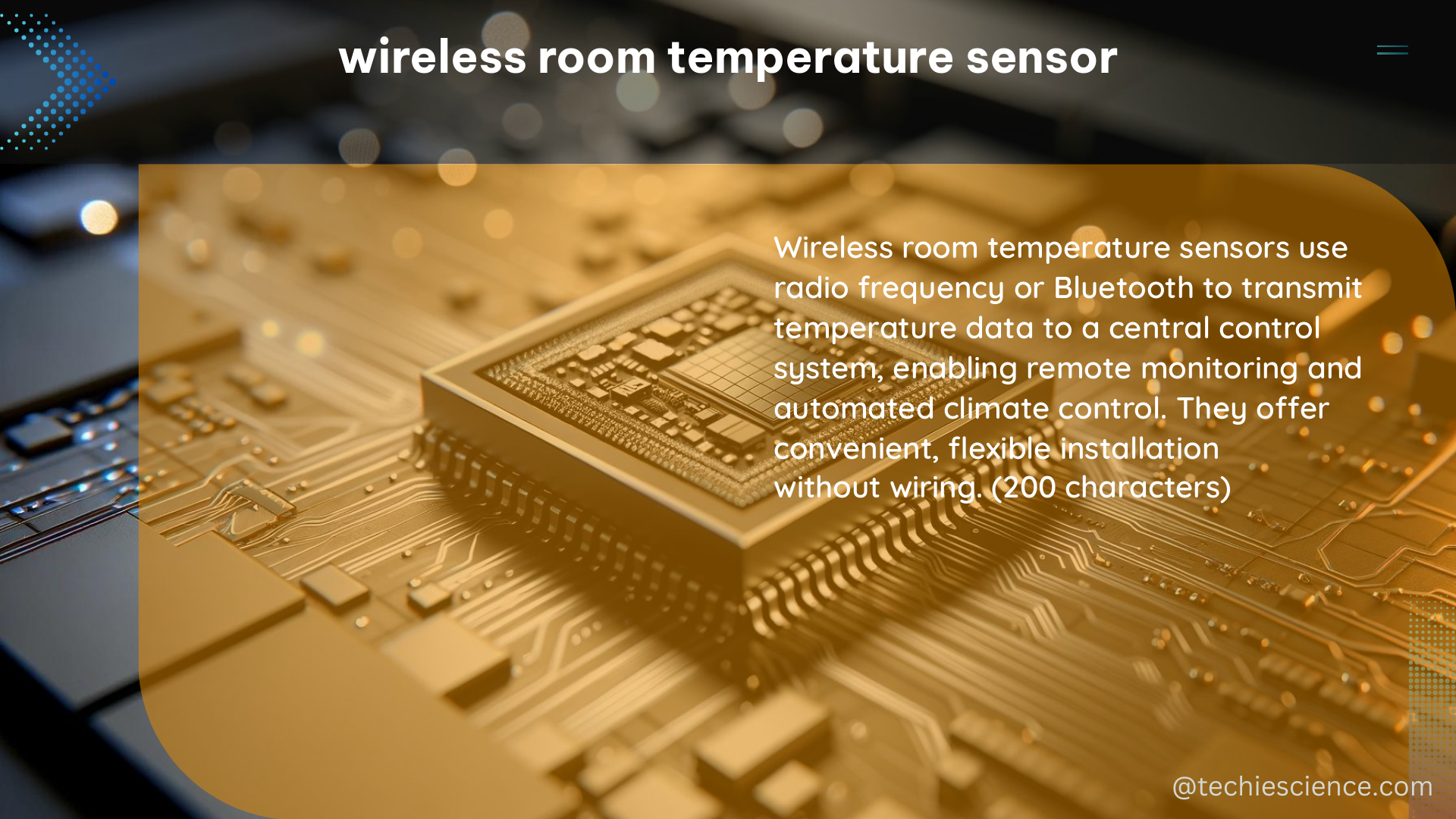A wireless room temperature sensor is a device that measures the ambient temperature of a room or space and transmits the data wirelessly to a central hub or receiver. These sensors are widely used in various applications, such as home automation, HVAC systems, and environmental monitoring, to provide real-time temperature data for efficient temperature control and energy management.
Understanding the Sensing Techniques
Wireless room temperature sensors can employ different sensing techniques to measure temperature, each with its own advantages and disadvantages:
-
Thermocouples: Thermocouples are simple and inexpensive temperature sensors that generate a small voltage proportional to the temperature difference between two junctions. They offer a wide temperature range, but have lower accuracy compared to other sensing methods, typically within ±1°C to ±2°C.
-
Resistance Temperature Detectors (RTDs): RTDs are highly accurate temperature sensors that measure the change in electrical resistance of a metal (usually platinum) as the temperature changes. They offer superior accuracy, typically within ±0.1°C to ±0.5°C, but are more expensive and have slower response times compared to thermocouples and thermistors.
-
Thermistors: Thermistors are temperature-sensitive resistors that exhibit a large change in electrical resistance with a small change in temperature. They provide high accuracy, typically within ±0.1°C to ±0.5°C, and fast response times, but can be affected by self-heating, which may require additional cooling measures.
The choice of sensing technique depends on the specific requirements of the application, such as the desired accuracy, temperature range, response time, and cost.
Wireless Communication Protocols

Wireless room temperature sensors can utilize various communication protocols to transmit data wirelessly, each with its own strengths and limitations:
| Protocol | Wireless Range | Power Consumption | Compatibility |
|---|---|---|---|
| Bluetooth | 10-100 meters | Low | Limited to Bluetooth-enabled devices |
| Wi-Fi | 50-100 meters | Medium | Widely compatible with Wi-Fi-enabled devices |
| Zigbee | 10-100 meters | Low | Requires a Zigbee gateway or hub |
| Z-Wave | 30-100 meters | Low | Requires a Z-Wave gateway or hub |
Bluetooth offers a shorter wireless range but lower power consumption, making it suitable for battery-powered applications. Wi-Fi provides a longer range and wider compatibility but consumes more power. Zigbee and Z-Wave have longer ranges and lower power consumption, but may require additional infrastructure, such as a gateway or hub, to connect to the internet.
Technical Specifications
When selecting a wireless room temperature sensor, consider the following technical specifications:
-
Temperature Range: The range of temperatures the sensor can measure, typically specified in degrees Celsius (°C) or Fahrenheit (°F). Common ranges include -40°C to 125°C (-40°F to 257°F) or -20°C to 50°C (-4°F to 122°F).
-
Accuracy: The degree of closeness between the sensor’s measurements and the true temperature value, usually expressed as a percentage or a number of degrees. High-end sensors can achieve an accuracy of ±0.1°C to ±0.5°C, while more affordable options may have an accuracy of ±1°C to ±2°C.
-
Resolution: The smallest change in temperature that the sensor can detect, often specified in fractions of a degree, such as 0.1°C or 0.01°F.
-
Response Time: The time it takes for the sensor to respond to a change in temperature, typically measured in seconds or milliseconds. Fast response times are important for applications that require real-time temperature monitoring.
-
Wireless Range: The maximum distance the sensor can transmit data wirelessly, usually specified in meters or feet. Ranges can vary from 10 meters (33 feet) for Bluetooth to 100 meters (328 feet) for Zigbee and Z-Wave.
-
Power Consumption: The amount of energy the sensor consumes while operating, typically measured in milliwatts (mW) or watt-hours (Wh). Low-power sensors are preferred for battery-powered applications.
-
Wireless Protocol: The communication standard the sensor uses to transmit data wirelessly, such as Bluetooth, Wi-Fi, Zigbee, or Z-Wave.
Building a DIY Wireless Room Temperature Sensor
For a DIY wireless room temperature sensor project, you can use the following components:
-
Microcontroller: An Arduino board or a Raspberry Pi can serve as the microcontroller to read the temperature data and transmit it wirelessly.
-
Temperature Sensor: Choose a temperature sensor, such as a thermistor or an RTD, that matches your accuracy and response time requirements.
-
Wireless Module: Depending on your wireless communication protocol preference, select a compatible wireless module, such as a Bluetooth, Wi-Fi, Zigbee, or Z-Wave module.
-
Power Source: Depending on your power requirements, you can use a battery or a power supply to power the sensor.
To build the DIY sensor, follow these general steps:
- Connect the temperature sensor to the microcontroller’s analog or digital input pins.
- Connect the wireless module to the microcontroller’s communication pins (e.g., UART, SPI, or I2C).
- Write a program to read the temperature data from the sensor, format it, and transmit it wirelessly using the selected protocol.
- Enclose the components in a suitable housing to protect them from the environment.
- Test the sensor’s performance, including its accuracy, response time, and wireless range.
By following these steps, you can create a customized wireless room temperature sensor that meets your specific requirements and integrates seamlessly with your home automation or environmental monitoring system.
References
- Wireless Sensor Networks: A Survey
- A Review on Wireless Sensor Networks: Design and Applications
- Design and Implementation of a Wireless Temperature Monitoring System Using Zigbee Technology

The lambdageeks.com Core SME Team is a group of experienced subject matter experts from diverse scientific and technical fields including Physics, Chemistry, Technology,Electronics & Electrical Engineering, Automotive, Mechanical Engineering. Our team collaborates to create high-quality, well-researched articles on a wide range of science and technology topics for the lambdageeks.com website.
All Our Senior SME are having more than 7 Years of experience in the respective fields . They are either Working Industry Professionals or assocaited With different Universities. Refer Our Authors Page to get to know About our Core SMEs.